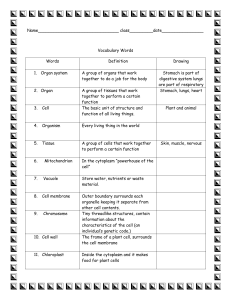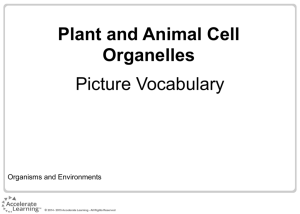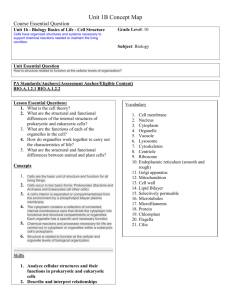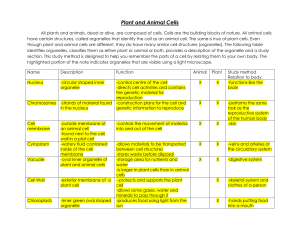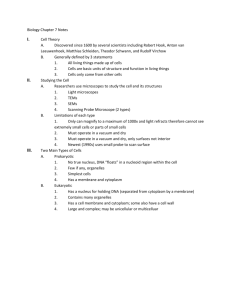LS09–Cell City - Science from Scientists
advertisement
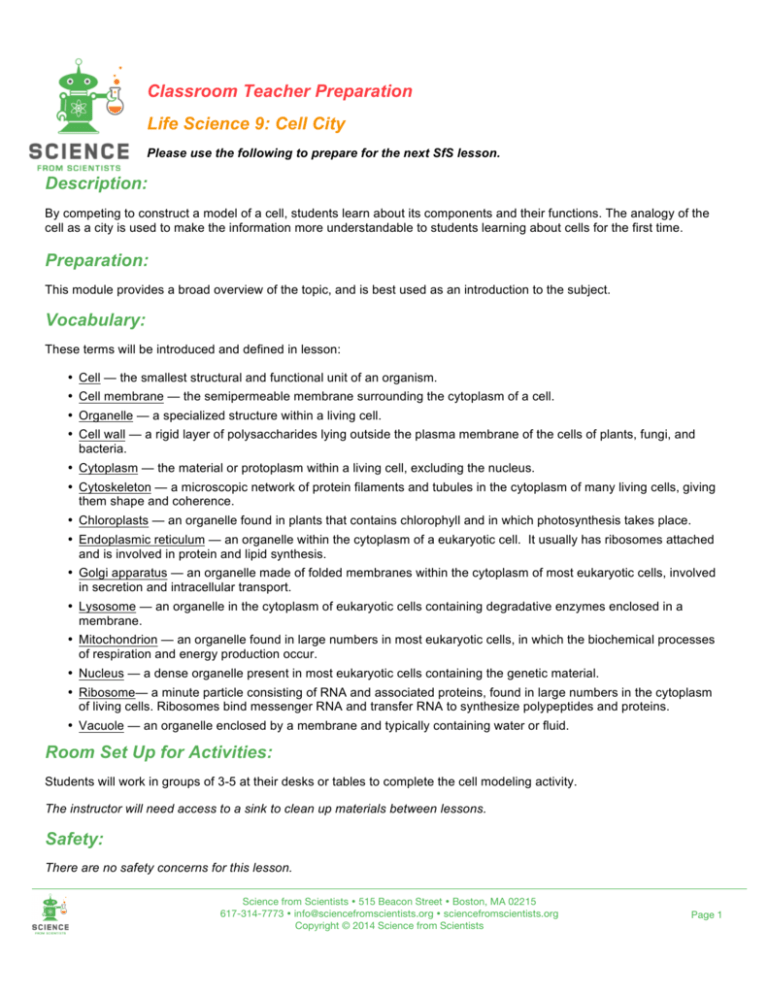
Classroom Teacher Preparation Life Science 9: Cell City Please use the following to prepare for the next SfS lesson. Description: By competing to construct a model of a cell, students learn about its components and their functions. The analogy of the cell as a city is used to make the information more understandable to students learning about cells for the first time. Preparation: This module provides a broad overview of the topic, and is best used as an introduction to the subject. Vocabulary: These terms will be introduced and defined in lesson: • Cell — the smallest structural and functional unit of an organism. • Cell membrane — the semipermeable membrane surrounding the cytoplasm of a cell. • Organelle — a specialized structure within a living cell. • Cell wall — a rigid layer of polysaccharides lying outside the plasma membrane of the cells of plants, fungi, and bacteria. • Cytoplasm — the material or protoplasm within a living cell, excluding the nucleus. • Cytoskeleton — a microscopic network of protein filaments and tubules in the cytoplasm of many living cells, giving them shape and coherence. • Chloroplasts — an organelle found in plants that contains chlorophyll and in which photosynthesis takes place. • Endoplasmic reticulum — an organelle within the cytoplasm of a eukaryotic cell. It usually has ribosomes attached and is involved in protein and lipid synthesis. • Golgi apparatus — an organelle made of folded membranes within the cytoplasm of most eukaryotic cells, involved in secretion and intracellular transport. • Lysosome — an organelle in the cytoplasm of eukaryotic cells containing degradative enzymes enclosed in a membrane. • Mitochondrion — an organelle found in large numbers in most eukaryotic cells, in which the biochemical processes of respiration and energy production occur. • Nucleus — a dense organelle present in most eukaryotic cells containing the genetic material. • Ribosome— a minute particle consisting of RNA and associated proteins, found in large numbers in the cytoplasm of living cells. Ribosomes bind messenger RNA and transfer RNA to synthesize polypeptides and proteins. • Vacuole — an organelle enclosed by a membrane and typically containing water or fluid. Room Set Up for Activities: Students will work in groups of 3-5 at their desks or tables to complete the cell modeling activity. The instructor will need access to a sink to clean up materials between lessons. Safety: There are no safety concerns for this lesson. Science from Scientists 515 Beacon Street Boston, MA 02215 617-314-7773 info@sciencefromscientists.org sciencefromscientists.org Copyright © 2014 Science from Scientists Page 1 Lesson Objectives – SWBAT (“Students Will Be Able To…”) 4-8 • Understand that cells function similarly in all living organisms • Describe the microscopic size of cells and recognize their scale compared to readily identifiable objects. • Explain that cell organelles have different jobs and all work together to keep the cell healthy and alive. • Understand that in multicellular animals, cells make up tissues and tissues make up more complex structures called organs. • Make and describe analogies between parts of a city and organelles of a cell. • Describe the methods for energy production and liberation in plant and animal cells. • Explain the characteristics that distinguish plant cells from animal cells, including chloroplasts and cell walls. 6-8 MCAS/NGS Standards Covered: MCAS Standards: th th 6 – 8 LS3 “Compare and contrast plant and animal cells, including major organelles (cell membrane, cell wall, nucleus, cytoplasm, chloroplasts, mitochondria, vacuoles).” th th 6 – 8 LS4 “Recognize that within cells, many of the basic functions of organisms (e.g., extracting energy from food and getting rid of waste) are carried out. The way in which cells function is similar in all living organisms.” NGS Standards: MS-LS1-2. Develop and use a model to describe the function of a cell as a whole and ways parts of cells contribute to the function. MS-LS1-3. Use argument supported by evidence for how the body is a system of interacting subsystems composed of groups of cells. Related Modules: Life Science 16: DNA is Everywhere - covers some basics of the role of DNA before students extract a visible sample of the molecule of life from food (strawberries, bananas or peas). Life Science 25: Plants - highlights the organelles specific to plant cells. Additional Resources: WGBH Videos and Activities: The PBS educational site is a great, free resource for educators but you must create an account to use the materials. The first time you log in to the PBS Learning Media website you will be asked to create an account and provide an email and password. Once you have logged in, select “keep me logged in” to avoid having to repeat the process. • Organelles in the Cytoplasm Video (6.06): http://mass.pbslearningmedia.org/resource/tdc02.sci.life.cell.organelles/organelles-in-the-cytoplasm/ Other Activities: • Interactive Cell Explorer: http://www.exploratorium.edu/traits/cell_explorer.html • Cells Alive Interactive: http://cellsalive.com/cells/cell_model.htm • Cell Labeling Interactive: http://scratch.mit.edu/projects/1884710/ Science from Scientists 515 Beacon Street Boston, MA 02215 617-314-7773 info@sciencefromscientists.org sciencefromscientists.org Copyright © 2014 Science from Scientists Page 2


